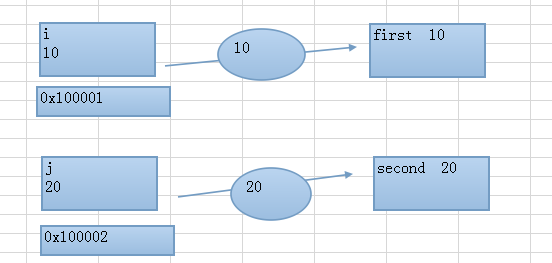1. Object.defineProperty
|
1 2 |
const obj = {}; Object.defineProperty(obj,prop,descript); |
- 参数 obj 要定义属性的对象
- prop 要定义的属性
- descript 属性描述符
返回值:被传递给函数的对象
descript接收一个对象作为配置:
- writable
属性是否可写 默认值fasle
- value
属性的值 默认值false
- enumerable
属性是否可枚举,关系到能否被for…in、Object.keys()以及in关键字遍 默认值false
- configurable 属性是否可以被defineProperty定义
- set setter函数
- get getter函数
使用defineProperty定义的属性descript默认值全为false
|
1 2 3 4 5 6 7 8 9 10 11 12 13 14 15 16 17 |
const obj = {}; obj.name = 'a'; //等同于 Object.defineProperty(obj,'name',{ configurable: true, value: 'a', writable: true, enumerable: true, }); conts obj1 = Object.defineProperty({},'name',{value: 'jack'}); //等同于 Object.defineProperty({},'name',{ value: 'jack', enumerable: false, writable: false, configurable: fasle, }) |
value和writable不能和setter与getter一起使用
|
1 2 3 4 5 6 7 8 9 10 |
const obj = Object.defineProperty({},name,{ writable:true, value: 'jack', set:function(newVal){ return newVal; }, get:function(val){ return val; } }); |
执行上面的代码出现异常:
Uncaught TypeError: property descriptors must not specify a value or be writable when a getter or setter has been specified.
也就是说我们使用writable和value或者set和get去定义属性的读写,不能混合使用
|
1 2 3 4 5 6 7 8 9 10 11 12 13 |
const obj = Object.defineProperty({},name,{ writable:true, }); const obj1 = Object.defineProperty({},name,{ set:function(newVal){ return newVal; }, get:function(val){ return val; } }); obj.name = 'ian'; obj1.name = 'jack'; |
2. Object.defineProperties
Object.defineProperties用法与Object.definePropert一致,可以同时定义多个属性
|
1 2 3 4 5 6 7 8 9 10 11 12 13 14 15 16 |
const obj = Object.defineProperties(obj, { name: { configurable: true, enumerable: true, writable: true, value: 'ian', }, gender: { writable: false, value: 'male' }, age: { set: function (val) { return val }, set: function (val) { return val }, } }); |
3. proxy
proxy的功能是代理对象,用于拦截对象的基本操作和自定义,与Object.defineProperty类似,区别是proxy代理整个对象,defineProperty只能代理某个属性。
语法
|
1 2 |
const obj = {}; const proxyObj = new Proxy({obj, handler}); |
handler 对象的方法:
- setProptotypeOf()
Object.setPropertyOf的捕捉器
- isExtensible()
Object.isExtensible的捕捉器
- preventExtensions()
Object.preventExtensions方法的捕捉器
- getOwnPropertyDescritor()
Object.getOwnPropertyDescriptor方法的捕捉器
- defineProperty()
Object.definePropert方法的捕捉器
- has()
in操作符的捕捉器
- deleteProperty()
delete操作符的捕捉器
- set
属性设置操作的捕捉器
- get
属性获取操作的捕捉器
- onwKeys
Object.getOwnPropertyNames和Object.getOwnSymbos的捕捉器
- apply
函数调用操作的捕捉器
- constructor
new操作符的捕捉器
使用get捕捉器
|
1 2 3 4 5 6 7 |
const obj = { name: 'ian', age: 21 }; const proxyObj = new Proxy(obj, { get: function (obj, prop) { return prop in obj ? obj[prop] : 'prop not existent'; }, }); console.log(proxyObj.gender); //prop not existent |
使用set捕捉器验证属性值
|
1 2 3 4 5 6 7 8 9 10 11 12 13 14 15 16 17 18 19 20 |
const obj = { name: 'ian' }; const proxyObj = new Proxy(obj, { set: function (obj, prop, value) { if (prop === 'age') { if (typeof value !== 'number') { throw new TypeError('The age is not Integer'); }; if (value > 200) { throw new RangeError('The age is not invalid'); }; } obj[prop] = value; //标识修改成功 return true; } }); proxyObj.gender = 'male'; //male proxyObj.age = '二十'; // Uncaught TypeError: The age is not Integer proxyObj.age = 201; //Uncaught RangeError: The age is not invalid proxyObj.age = 20; //20 |
捕获new操作符
|
1 2 3 4 5 6 7 8 9 10 11 |
function Person(name) { this.name = name; }; const ProxyPerson = new Proxy(Person, { construct: function (target, args) { //使用原本的构造函数 return new Person(...args); } }) var jack = new ProxyPerson('jack'); console.log(jack);//Object { name: "jack" } |
捕获函数调用
|
1 2 3 4 5 6 7 8 9 10 11 12 13 14 15 |
//执行原本的函数 const proxyFoo = new Proxy(log,{ apply:function(target,that,args){ target(args); } }); proxyFoo('foo'); //foo //自定义函数 const proxyFoo1 = new Proxy(log, { apply: function (target, that, args) { //将log改成alert执行 alert(args); } }); proxyFoo1('foo'); //foo |
代理模式
当我们去访问一个数据的时候,不直接去访问数据,而是通过代理(Proxy)作为一个中间者替我们去获取和设置数据,在proxy层可以做一些访问控制等, 例如进行数据的校验数,据合法后再设置给原数据,起到一个保护和校验的功能。常见的代理模式有:
- 保护代理
给被调用者提供访问控制,确认调用者的权限
- 远程代理
- 虚拟代理
用来代替巨大的对象,确保在需要的时候才被创建
- 智能引用代理
总结
- proxy是浏览器提供的代理方式,相比较defineProperty来说Proxy更加灵活,能代理对象的多个属性
- proxy还能捕捉和拦截数组、函数、构造器、以及Object的一些方法和操作符


